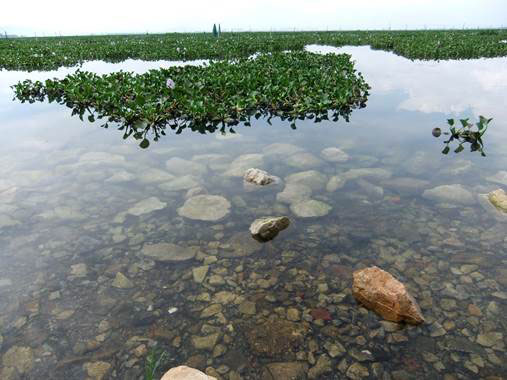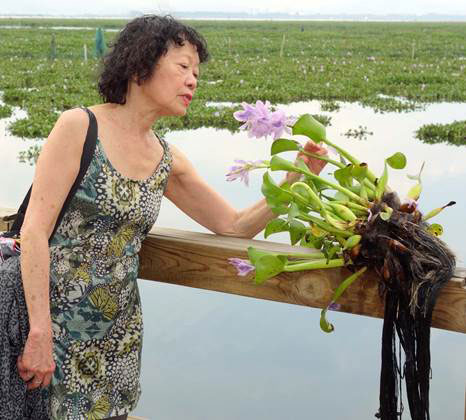A weed that has spread from South America to many tropical and semi-tropical countries now developed by Chinese scientists into a variety that is far less invasive and very effective at cleaning heavily polluted lakes and rivers Prof Peter Saunders
Kunming, the capital of Yunnan province in southwest China, has traditionally been a trading centre, the gateway to Southeast Asia. It is now also a major industrial city with a population of some seven million and, like other large cities in China, new buildings going up everywhere.
Prosperity has brought with it serious environmental problems, especially in the water supply. Kunming is situated on the northern shore of Dianchi, a lake about 300 km2 in area. Fifty years ago, it was clear and clean. It supported a significant fishing industry and people swam in it. The water was then classified as “drinkable with ordinary treatment.” By the 1990s, however, it had deteriorated to the point where it was considered untreatable [1].
The chief causes of the pollution are inadequate treatment of waste from Kunming and the run off of fertilisers and pesticides from farms along the tributaries and on the shores of the lake itself. There are also two million people living around Dianchi, and until 2012, 280 000 tons of untreated waste water a day were being discharged into the lake.
Geography also plays a role. Kunming is upstream from the lake so any pollution from the city flows directly into it. Thirty six rivers flow into Dianchi but only one flows out, so the mean residence time for water entering the lake is four years, and pollutants accumulate.
The local government has been wrestling with the problem for 40 years. There have been improvements along the rivers that flow into Dianchi, reforestation along its shores, and the construction of wetlands where the rivers flow into the lake. In 2012, a new drainage system was completed in Kunming to separate rainwater from sewage, though this is still not sufficient to deal with the flow during the rainy season [2].
Dianchi suffers from eutrophication, which leads to a large density of cyanobacteria. There is also a high level of heavy metals, especially arsenic. To remedy this, the local government introduced water hyacinth into the lake in 2005 [2]. This was a calculated risk, because while water hyacinth is effective at removing many pollutants, notably nitrogen, phosphorous, and heavy metals; it is also an invasive species that spreads very rapidly. This makes it a serious problem in many tropical and subtropical countries. In Dianchi, it led to a sharp reduction in dissolved oxygen [3]. Decaying roots from dead plants made the eutrophication even worse.
The water hyacinth had to be removed from the lake, with difficulty; and since 2007 it is being replaced by a different variety, the purple root water hyacinth, developed by the Yunnan Institute of Ecological Agriculture (IEA). This reproduces at only about a third the rate of the American variety. It also has smaller leaves, so some sunlight reaches the surface of the water. It is effective at degrading cyanobacteria and its roots also provide oxygen for aquatic organisms. It rapidly reduces the total nitrogen and phosphorous content and it absorbs arsenic at 52 times the rate of the Chinese ladder brake fern (Pteris vittata), a well known hyperaccumulator of arsenic [3]. (A hyperaccumulator is a plant that takes up a toxin to concentrations greater than that in the soil in which it is growing.) A powder made from the dried roots can be used to remove heavy metals from water [4]. The director of the IEA, Na Zhong-Yuan, has developed a form of fertiliser that makes the plants develop more rapidly and grow much longer roots, and preliminary trials have indicated faster and more effective remediation (see photographs). When we visited Dianchi, he told us that this was based on the same sorts of herbs that are used in traditional Chinese medicines. The formulation is, however, still secret.

Lake water cleared by Na’s improved purple hyacinths

Improved purple hyacinth in flower
Like other water hyacinths, the purple root variety can be used as fodder, though this is not advised if it is has been used to remove heavy metals from water. It is also a source of fibres and is an excellent feedstock for biogas digesters [5].
In August 2011, purple root water hyacinths were planted in a part of Dianchi. Before the trial began, the water was green and had an unpleasant smell. According to the IEA, the total nitrogen was 167mg/L and the total phosphorus was 48.4 mg/L. The algal biomass was 2.11×1010 mg/L and the oxygen demand, a commonly used measure of the amount of organic compounds in the water, was 900 mg/L.
By 7 September, the odour had gone, the water was pale green and the bottom of the lake was visible for the first time in years. The total nitrogen had fallen to 0.794 mg/L, the total phosphorus to 0.069 mg/L, and the algal biomass to 1.62× 107 mg/L. The oxygen demand was now only43.9 mg/L [6].
A shortage of potable water continues to be a problem for Kunming as it is for many cities in China and elsewhere. To remedy it will require many different measures, chief among which are to reduce the pollution that enters Dianchi and to remove as much as possible of any that does. The development and introduction of the purple root water hyacinth is an important part of the strategy.
Water hyacinth grows well in many tropical and subtropical environments, which is why it has become a problem. Fortunately, this also means that other regions both in China and across the world should be able to follow Kunming and use the purple root water hyacinth to help rid their lakes and rivers of pollution.
Article first published 09/09/13
Got something to say about this page? Comment